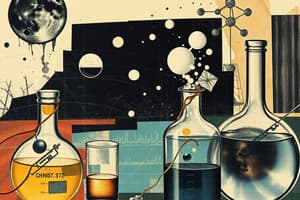Podcast
Questions and Answers
What is matter?
What is matter?
Anything that occupies space and has mass.
Which of these is a physical change?
Which of these is a physical change?
- Melting ice (correct)
- Baking a cake
- Rusting iron
- Burning wood
What are the four elements that make up 96 percent of the body?
What are the four elements that make up 96 percent of the body?
Oxygen, Carbon, Hydrogen, Nitrogen.
What is kinetic energy?
What is kinetic energy?
Chemical energy is stored in the chemical bonds of substances.
Chemical energy is stored in the chemical bonds of substances.
What is a molecule?
What is a molecule?
What distinguishes a compound from a molecule?
What distinguishes a compound from a molecule?
What is the most abundant inorganic compound in the body?
What is the most abundant inorganic compound in the body?
What is the pH scale range?
What is the pH scale range?
Which of the following is a characteristic of saturated fats?
Which of the following is a characteristic of saturated fats?
Proteins account for over half of the body's organic matter.
Proteins account for over half of the body's organic matter.
What are enzymes?
What are enzymes?
Study Notes
Matter and Energy
- Matter is defined as anything that occupies space and has mass.
- Exists in three states: solid (definite shape and volume), liquid (definite volume, takes shape of container), and gaseous (no definite shape or volume).
- Matter can change physically (state changes without altering substance) or chemically (changes chemical composition).
Composition of Matter
- Elements are the fundamental units of matter; 96% of body mass is from four key elements:
- Oxygen (O) – 65% of body mass
- Carbon (C)
- Hydrogen (H)
- Nitrogen (N)
- The periodic table lists all known elements.
Energy
- Energy is the ability to do work; it has no mass and occupies no space.
- Types of energy include:
- Kinetic energy: energy in motion
- Potential energy: stored energy
Forms of Energy
- Chemical energy: stored in chemical bonds
- Electrical energy: results from movement of charged particles
- Mechanical energy: involved in moving matter
- Radiant energy: energy that travels in waves, part of the electromagnetic spectrum
Molecules and Compounds
- Molecules consist of two or more atoms of the same element combined chemically (e.g., H + H → H2).
- Compounds are formed from different elements combined chemically (e.g., 4H + C → CH4 for methane).
Biochemistry: The Chemical Composition of Living Matter
- Inorganic compounds lack carbon, are small/simple, examples include water, salts, and some acids and bases.
- Organic compounds contain carbon, are large/covalent molecules, include carbohydrates, lipids, proteins, and nucleic acids.
Inorganic Compounds
- Water is the most abundant inorganic compound in the body, making up two-thirds of body weight.
- Salts are ionic compounds that dissociate into ions in water, essential for various body functions.
- Acids are electrolytes that release hydrogen ions (H+) in water, while bases release hydroxyl ions (OH-).
- The pH scale measures the concentration of H+ ions in fluids, ranging from 0 to 14.
Organic Compounds
- Carbohydrates consist of carbon, hydrogen, and oxygen; they include sugars and starches and are classified by size:
- Monosaccharides: simple sugars, basic building blocks
- Disaccharides: two simple sugars linked
- Polysaccharides: long chains of simple sugars
Lipids
- Major types include triglycerides, phospholipids, and steroids; they contain more carbon and hydrogen than oxygen.
- Lipids are insoluble in water but soluble in other lipids.
- Fatty acids can be saturated (solid at room temperature) or unsaturated (liquid at room temperature, “heart-healthy”).
- Trans fats are unhealthy, increasing heart disease risk.
- Omega-3 fatty acids in fish and certain plants can decrease heart disease risk.
Phospholipids and Steroids
- Phospholipids have two fatty acid chains; a hydrophobic tail and a charged hydrophilic head.
- Steroids consist of four interlocking rings; important examples include cholesterol and hormones. Cholesterol is produced by the liver and ingested from animal sources.
Proteins
- Comprise over half of the body’s organic material, providing structure and playing critical roles in cell function.
- Proteins act as enzymes, hormones, and antibodies and are made from amino acids, which contain carbon, oxygen, hydrogen, nitrogen, and sometimes sulfur.
Enzymes
- Enzymes function as biological catalysts to speed up chemical reactions.
- They bind substrates at active sites to facilitate reactions.
Studying That Suits You
Use AI to generate personalized quizzes and flashcards to suit your learning preferences.
Related Documents
Description
This quiz covers the fundamental concepts of basic chemistry, focusing on matter and its three states: solid, liquid, and gas. It also explores the types of changes matter can undergo, both physically and chemically. Test your knowledge on these essential principles of chemistry in relation to anatomy and physiology.




